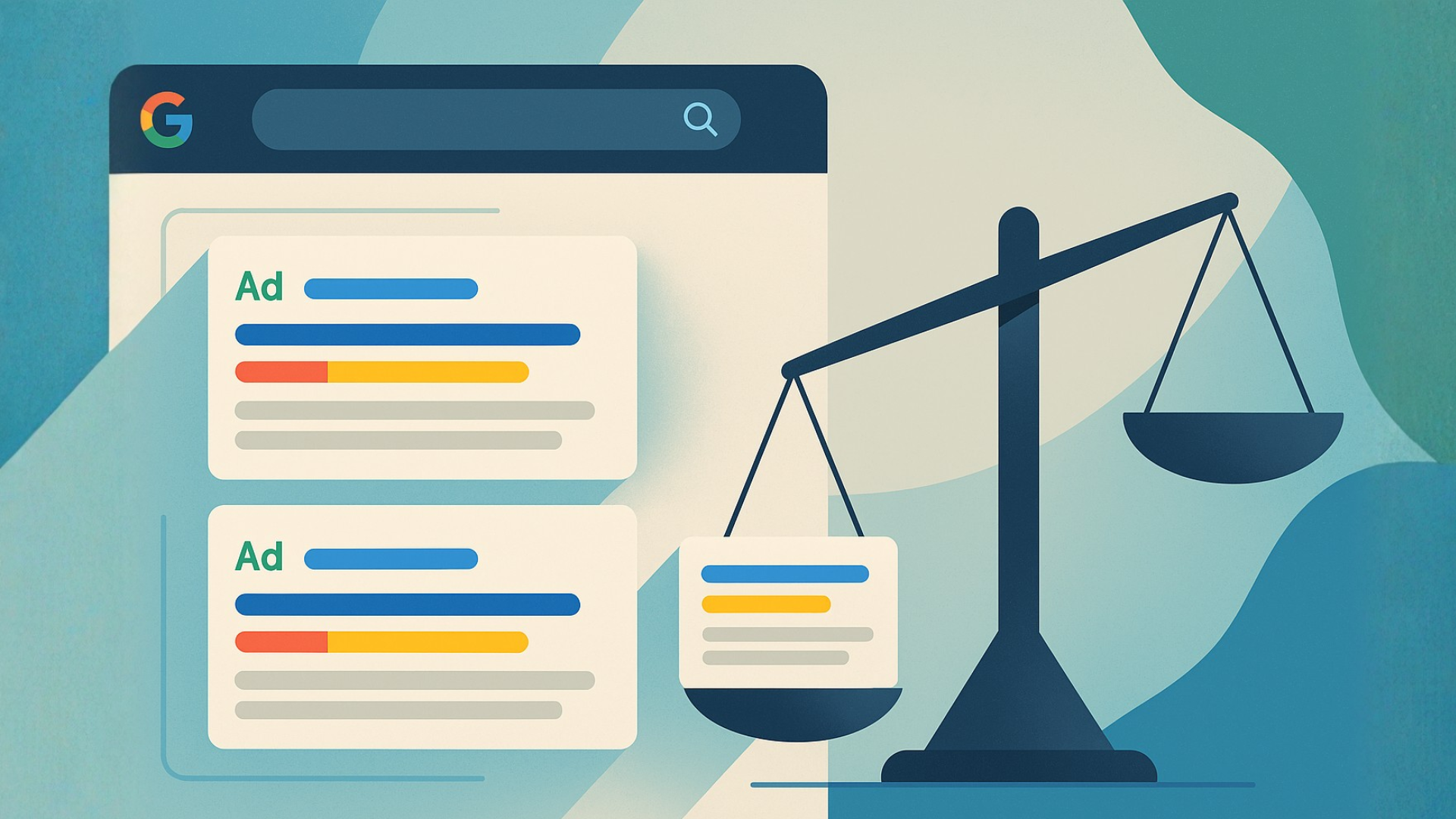Google’s double-serving dilemma: Who really wins when one advertiser gets two spots?

Google changed one of its most fundamental advertising rules on April 14, and some marketers didn’t even notice.
Buried in a policy update to the Unfair Advantage section, Google announced that advertisers could now appear more than once on the same search results page, provided each ad appears in a different ad location.
Simply put, a single advertiser can now occupy multiple positions on one SERP. The move was framed as a way to “increase fairness and improve user choice.”
But for advertisers already battling rising CPCs, shrinking control, and an opaque auction, the change raises a much more uncomfortable question:
How fair can an auction really be when one advertiser can win twice?
From ‘one ad per advertiser’ to ‘multiple ads per page’
Until this year, Google’s double-serving policy was fairly simple: you couldn’t show more than one ad for the same business, product, or site on a single results page.
The idea was to prevent large advertisers from flooding the auction and dominating visibility.
Google updated its policy in April to allow advertisers to serve multiple ads, provided each appears in a different ad location.
- “[We’re allowing] relevant Search ads from advertisers who showed amongst top ads to also participate in the bottom ads auction,” Google wrote. “However, within a single ad location (either top or bottom), we will continue to apply and enforce the existing policy.”
The real-world effect?
You may now see the same company displaying an ad in both the top block and the bottom, both marked as sponsored results.
In theory, this gives users more “relevant options.”
In reality, it gives advertisers with deeper budgets a structural advantage.
How it’s playing out in the wild
Initial evidence suggests that this policy shift has tangible consequences in live auctions.
Platforms like Adthena have reported cases where advertisers appear twice on a SERP. Impressions increase, but clicks don’t scale proportionally, leading to a lower CTR.
They also note that impression share can decrease because the pool of eligible impressions expands.
Furthermore, Auction Insights are becoming increasingly difficult to interpret under double-serving.
Changes in impression share/overlap may reflect double-serve dynamics rather than genuine competitiveness, meaning the report may no longer reflect reality without additional context.
Operationally, that means you can see more “visibility” on paper while efficiency and clarity degrade. Making decisions driven purely by Auction Insights risk misallocation.
Why this hits SMBs hardest
For enterprise advertisers, double-serving can be a strategic advantage. You can promote different products, landing pages, or funnel stages simultaneously.
A top-of-page brand ad might focus on awareness, while a lower-page ad captures last-click conversions.
But for small-to-medium advertisers, this update quietly widens the gap.
When a national brand can afford to run multiple campaigns, it can now dominate both ad blocks. A local business, even one with a strong Quality Score, might not even get a spot.
This just compounds an already uneven landscape where automation, data scale, and budget size increasingly determine who wins visibility.
Transparency is the first casualty
At the same time, Google also rolled out a new “Sponsored results” label.
Instead of labelling each ad individually, ads are now grouped under a single, larger label at the top of the block.
Users see “Sponsored results” once, then scroll through multiple ads.
For users skimming results, the distinction between paid and organic becomes less obvious.
From a transparency standpoint, this is a regression.
For years, users were trained to look for small “Ad” tags to differentiate paid results from organic listings.
Now, with one global label and potentially the same advertiser showing twice on the SERP, the boundary between paid and organic visibility gets fuzzier.
Reporting reality
It’s not just users who lose clarity. Advertisers do, too.
Even though Google Ads reports on top-of-page visibility through impression share metrics, there isn’t a new reporting view showing when an ad appears in both top and bottom locations.
Google confirms that the way impressions, clicks, and conversions are counted has not changed.
You can, however, segment by “Top vs. Other” to approximate performance across top and bottom locations.
“Other” captures impressions shown below the organic listings, effectively representing the bottom block.
Google also clarified that nothing fundamental is changing “behind the curtain.”
Ad Rank continues to determine whether an ad is eligible to show and in which location it appears relative to competitors.
The only structural change is that advertisers whose ads appear in the top ad positions are now also eligible to compete in the auction for bottom ad positions.
As a result, you may notice a shift in Top/Absolute Top Impression Rate and potentially a small movement in CTR as distribution normalizes across both ad blocks.
Who actually wins?
If we’re being honest, this change primarily benefits Google and large advertisers.
Google wins by allowing multiple ads per advertiser, effectively expanding its inventory without increasing the number of searchers.
More ad slots filled = more total paid clicks per query.
With the Sponsored Label change, users will have a harder time distinguishing between ads and organic, resulting in a lot of clicks that were never meant to happen.
Big advertisers win with deep budgets.
They can capture more SERP real estate and use multiple messages to dominate user attention. It’s brand insurance: even if the first ad doesn’t get the click, the second might.
Small advertisers with limited budgets lose out on fewer impressions, higher CPCs, and increased competition.
Even if your ad quality is strong, you’re fighting against brands that can now show twice as often.
The ecosystem loses balance when auctions are supposed to reflect merit and relevance.
Double-serving bends that principle. It’s no longer about which ad best serves the user – it’s about who can afford to occupy more space.
Get the newsletter search marketers rely on.
See terms.
What SMBs can do about it
While you can’t control where Google decides to place your ads, you can control how you monitor and respond to the changes this policy introduces. Here’s how to stay proactive:
1. Audit your query overlap
Double-serving can mean self-competition.
Use the Search Term Reports or scripts that surface queries triggered by multiple campaigns.
If the same search term is firing across brand, non-brand, or Performance Max campaigns, evaluate whether both placements add value or if one is cannibalizing the other.
2. Segment intentionally
Give each campaign a defined role in the funnel.
Use separate campaigns for discovery, brand, and conversion-driven intent to ensure they’re not competing for the same traffic.
This reduces internal bidding overlap and helps you preserve budget efficiency across campaign types.
3. Monitor location performance with the right segmentation
There isn’t new reporting that shows when your ad appears in both the top and bottom ad locations.
Google has confirmed that the way impressions, clicks, and conversions are counted hasn’t changed.
However, as mentioned earlier, you can segment by “Top vs. Other” to understand how performance differs between ads that appear above versus below organic results.
4. Manage budgets to prevent self-competition
If two campaigns target similar queries or audiences, they can unintentionally drive each other’s bids higher.
Keep budgets segmented by funnel stage, and use shared negatives or ad group/campaign-level exclusions to prevent overlap before it occurs.
5. Focus on efficiency, not visibility
With advertisers now eligible to compete in both ad locations, total impressions may rise, but that doesn’t automatically mean better performance.
Re-evaluate your KPIs: prioritize cost per qualified conversion and lead quality over impression share or CTR alone.
If you want to monitor exposure changes, the “Top vs. Other” segmentation provides a more reliable signal than raw impression share.
6. Educate clients or leadership
Prepare stakeholders for the metric shifts.
Top/Absolute-Top Impression Rate may change as ads redistribute across top and bottom locations, and CTR may fluctuate accordingly.
Use this as an opportunity to reinforce what actually matters, conversions and profitability, not position vanity.
Why this change deserves more scrutiny
Google will argue that this update benefits users by improving “choice.”
But the logic is circular: when one advertiser occupies more than one slot, choice narrows, not widens.
The move also hints at a broader trend, Google’s gradual redefinition of “fairness.”
Once, fairness meant equal opportunity in the auction. Now, it increasingly means equal algorithmic treatment, regardless of who can afford to spend more.
This may sound academic, but for practitioners, it’s not.
Every shift like this erodes the integrity of the auction model.
When budgets can buy duplicate visibility, the system stops rewarding quality and starts rewarding scale.
The bigger picture
If you zoom out, double-serving isn’t an isolated policy tweak – it’s part of a larger pattern.
Over the last few years, we’ve watched automation dissolve many of the traditional guardrails of account management:
- Broad match paired with tCPA/tROAS replaces keyword control.
- Performance Max replaces campaign-level segmentation.
- Now, double-serving blurs the auction boundaries themselves.
Each change, in isolation, seems logical. But together, they redefine what “fair competition” means inside Google Ads.
Automation promises efficiency, but efficiency without transparency is just convenience for the platform.
The cost of taking two seats at the table
This isn’t about whether Google should allow multiple ads per advertiser. It’s about what happens when they do.
If one advertiser can take two seats at the same table, everyone else has less room to eat.
For those of us managing campaigns every day, that means two takeaways:
- Stay vigilant about how your campaigns interact with each other, not just with competitors.
- Keep asking the uncomfortable questions about fairness, transparency, and control.
Because those questions aren’t theoretical anymore. They’re showing up on Page 1.







Recent Comments